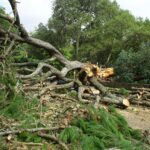At a glance:
- Drought stress can have significant short-term and long-term impacts on tree health, affecting their physical and physiological functions.
- Recognising signs and symptoms of drought stress are crucial for timely intervention and tree care to prevent further damage.
- Proper tree care during a drought includes slow and steady watering, selecting drought-tolerant tree species, and monitoring signs of stress.
Have you ever noticed how your surrounding trees droop and wither away during prolonged dry spells? This is because, just like all living organisms, drought stress can affect trees.
As a homeowner or environmental enthusiast, it is crucial to understand the impacts of drought stress on tree health. Whether you want to protect the natural beauty of your suburban community or admire the beauty of trees, keeping a few key points in mind can help minimise the negative impact of drought stress and secure the health of your trees.
So, let’s dive into understanding drought stress and how it affects trees.
What is drought stress on a tree?
Drought stress on trees is caused by prolonged periods of water shortage. The lack of water leads to primary and secondary physical damage to trees. The roots are the first affected, and nonwoody feeder roots located in the top 15 inches of soil are particularly sensitive.
When the roots dry out and become nonfunctional, the top of the plant experiences a water deficit. Furthermore, drought-stressed trees undergo many metabolic changes, significantly altering their physiology. Symptoms associated with drought stress are often only evident sometime after the event, even as much as one to two years later.
The symptoms can vary, including turgor loss in needles and leaves, drooping, wilting, curling, yellowing, and premature leaf drop. Giving trees supplemental water is the most helpful way to reduce stress during drought conditions. Depending on your tree and the area you live in, you must water it regularly and in what amount. If you see signs of stress in your trees and the ground under them is extremely dry, it’s time to start watering.
Impact of drought stress on tree health
Drought stress can have a significant impact on the health of trees. Direct physical damage to the roots and root death are the primary effects of drought, which can result in a water deficit that affects the top of the plant. Many metabolic changes also occur, altering the physiology of drought-stressed trees. Species that are normally considered drought-tolerant can still exhibit symptoms of drought stress.
Seedlings and new transplants are particularly vulnerable since their roots occupy the uppermost soil layers where the most rapid drying occurs. Symptoms of drought stress are generally only evident sometime after the event, making accurate diagnosis difficult. Furthermore, established trees and shrubs, especially those growing in marginal soils, are also affected by droughts.
Drought exacerbates even subtle improper planting practices. Symptoms of drought stress can include loss of turgor in needles and leaves, drooping, wilting, yellowing, premature leaf or needle drop. During extended periods of drought, careful attention should be given to woody transplants and established trees and shrubs to minimise the adverse effects of water stress.
Short-term impacts of drought on tree health
The short-term impacts of drought on tree health are significant and can be observed in various ways. During drought, trees experience physical damage and physiological changes that jeopardise their health and survival. The roots of trees are particularly vulnerable to drought, with feeder roots in the top layer of soil usually the first to die from lack of water. As a water deficit develops, this directly impacts the trees’ health, making it difficult for the roots to provide water to the rest of the plant.
Woody transplants, in particular, are susceptible to drought stress since their roots are vulnerable during the planting process and often take years to establish in a new site fully. Established trees may also experience drought stress, and symptoms are usually subtle and not diagnostic, making it difficult for accurate diagnosis. Symptoms can include loss of turgor in needles and leaves, wilting, yellowing, premature leaf or needle drop, and more. Drought stress can significantly impact tree health, and proper management practices should be adopted to prevent or mitigate such effects.
Long-term impacts of drought on tree health
The long-term effects of drought are often only apparent after some time. Understanding the impact of drought on plants requires a review of water relations. Water is a vital component of plant life and serves as a raw material for many metabolic processes, including photosynthesis. The uptake and transport of mineral nutrients in soil water move into plant roots and the vascular system. Any interruption can stop or reduce the water flow, resulting in leaves wilting and even cell death.
While severe droughts are likely to injure plants that grow naturally in a given site, established trees and shrubs selected and planted by humans are also vulnerable, especially when planted in unfavourable sites. The long-term impacts of drought on tree health can be significant, and it is crucial to provide extra care and attention to trees during extended periods of drought to ensure their survival and health.
Signs and symptoms of drought stress in trees
When trees experience drought stress, their physical and physiological functions can be drastically impacted. One of the primary physical effects is root damage and death, particularly in nonwoody feeder roots located in the top 15 inches of soil. This leads to a water deficit since the roots cannot supply the plant with water.
Additionally, many metabolic changes occur, such as alterations in hormone levels and the closing of stomata. Seedlings and new transplants are especially vulnerable to drought stress because their roots are in the uppermost soil layers, where rapid drying occurs.
Drought-stressed trees often exhibit symptoms such as loss of turgor, drooping, wilting, curling, yellowing, premature leaf or needle drop, and stunted growth. However, these symptoms can manifest in one to two years and may not be specific or diagnostic. Therefore, accurate diagnosis can be challenging.
In addition, drought-stressed trees are more susceptible to insect and mite damage. To help prevent drought stress, homeowners should properly water their trees and pay attention to the potential signs of drought stress to avoid bigger problems and preserve the health of their valuable trees.
Tree care tips during a drought
During a drought, it is important to ensure that trees receive adequate care to maintain their health. Understanding the signs of drought stress, such as wilting, curling, yellowing leaves, premature leaf drop, or stunted growth, is essential. To prevent drought stress, homeowners should water trees slowly and steadily, ideally with a soaker hose, to ensure the water reaches the root system.
It is best to water in the early morning or evening to avoid mid-day evaporation. Overhead watering should be avoided as it can promote disease and not reach the root system. Trees that have recently been transplanted or planted need extra care during extended periods of drought.
Additionally, drought can increase even minor improper planting practices, highlighting the importance of proper planting techniques. Maintaining healthy trees involves promptly identifying and addressing drought stress before significant damage occurs.
Preventative measures
Preventative measures are crucial in mitigating the negative impacts of drought stress on trees. It is important to select drought-tolerant species for newly transplanted trees and plant them in well-draining soil that can retain moisture.
Adequate irrigation, carefully managed watering schedules, and mulch can all contribute significantly to supporting tree health during periods of drought. For established trees, one should avoid over-watering during dry periods, which can lead to root rot and other diseases. It is also important to monitor the trees for signs of drought stress, such as the loss of turgor in needles or leaves, wilting or drooping, yellowing or curling, and premature leaf or needle drop.
If these signs are present, immediate action should be taken to alleviate drought stress, including increased watering, soil amendments, or the application of specialised fertilisers.
Conclusion
In conclusion, understanding the impact of drought stress on tree health is crucial for maintaining and preserving the well-being of our trees. Both short-term and long-term effects can significantly impact tree health and survival. Recognising the signs and symptoms of drought stress allows us to take appropriate measures to support trees during water scarcity. Implementing proper tree care practices, such as adequate watering, mulching, and pruning, can help mitigate the effects of drought and improve tree resilience.
Furthermore, taking preventative measures, such as selecting drought-tolerant tree species and improving soil moisture retention, can help prepare trees for future drought conditions. By staying informed and proactive, we can protect our valuable tree resources and promote a healthier and greener environment for future generations.
Look no further than Same Day Tree Works for all your tree maintenance needs in Melbourne. We are your trusted and affordable tree service provider, dedicated to delivering high-quality and affordable tree service. Whether you require pruning, tree removal, or stump grinding, our experienced team is equipped to handle everything. With a focus on safety, professionalism, and customer satisfaction, we ensure your trees receive the best care possible.
Contact us today to schedule an appointment and experience our exceptional tree services at affordable prices. Your trees deserve the best, and we’re here to deliver.





